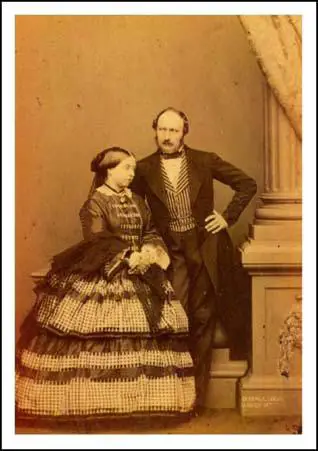|
The
History of Photography in Brighton
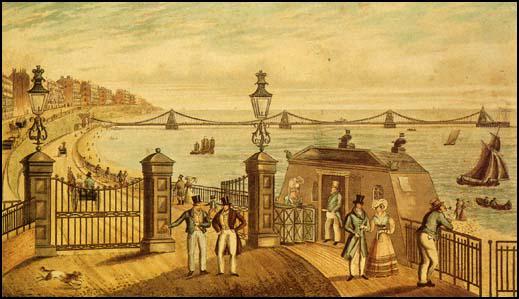
The
Chain Pier and Marine Parade, Brighton (c. 1830).Drawn and engraved
by John Bruce.
The
Chain Pier, Britain's
first seaside pleasure pier, was opened on 25th November 1823.
At top left can be seen the houses that lined Marine Parade. William
Constable's
Photographic Institution
was situated at No 57, to the left of the first pier tower.
PART
1: THE EARLY YEARS OF PHOTOGRAPHY IN BRIGHTON [ 1841-1854]
Section A :
The Beginning of Photography in Brighton ;
William
Constable and The Photographic Institution of Brighton
Brighton's
First Photographic Studio
Brighton’s first photographic studio opened on Monday 8th November
1841 at 57 Marine Parade, a large house situated on Brighton’s
eastern seafront. Two days later, the ‘Brighton Guardian’
carried a notice dated 9 November 1841, in which “The Proprietor
of The Photographic Institution” at 57 Marine Parade announced
that his Establishment was now open to the public. [SOURCE
1] On the same page of the ‘Brighton Guardian’,
a correspondent of the newspaper welcomed the opening of the Photographic
Institution, which he believed would supply “what has been
long felt to be a great desideratum*
in society, - the means of securing a correct likeness without the
tedium of sitting for hours to an artist”
*desideratum = “a thing wanted
or desired"
William
Constable
Neither the article or the advertisement in the Brighton Guardian
of 10 November 1841 mentions the name of “The Proprietor”
of the Photographic Institution. The anonymous proprietor
was William Constable, a multi-talented
man, who at the age of 58 was entering a new field of enterprise,
which would draw upon those inventive skills which he had previously
demonstrated in the world of science, art and business.
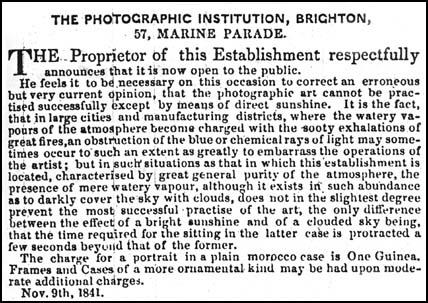
Advertisement
for William Constable's Photographic Institution ( Brighton Guardian
10 November 1841)
In the 1851 Census, William Constable gave his occupation as ‘Flour
Manufacturer and Heliographic Artist’, but this description
fails to reflect what had up to then been an extraordinary and colourful
career. A man without the benefit of an extended formal education,
William Constable had worked at various times as a successful high
street draper, an inventor of scientific devices, a watercolour
artist, cartographer, land surveyor, architect , bridge builder,
engineer, and the surveyor of a thirty mile stretch of the London
to Brighton Turnpike Road. [SOURCE
2] At an age when most men would be entering the last stage
of their working life, William Constable decided to embrace a new
technology and embark on a new career as a Photographic Artist.
Constable
in America
During
his lifetime, William Constable made a total of three visits to
America and it is possible that on his last trip to the States
in 1840, he had the opportunity to study the commercial possibilities
of the recently invented art of photography. Louis Jacques
Mande Daguerre, a French theatrical designer and showman had
perfected the technique of fixing an image on a silver-coated
copper plate in the late 1830s and the process had been announced
to the world in Paris in August 1839. This early form of photograph
was given the name daguerreotype by its inventor. The first
successful American daguerreotype was made in New York in September
1839 . Alexander Wolcott and his business partner John Johnson
opened the world’s first daguerrian portrait studio in New
York at the beginning of March 1840. Given Constable’s intellectual
curiosity and his fascination with scientific processes, it is
likely that he took an early interest in the new art of photography
and while in America he had the opportunity to observe the work
of early American daguerreotypists and see the commercial potential
of producing and selling photographic portraits.
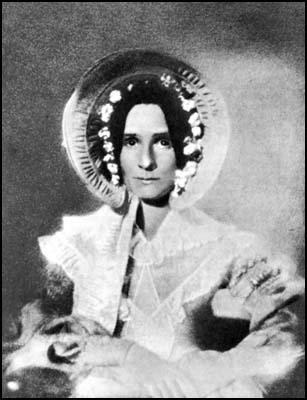
Miss Dorothy Draper,an American daguerreotype
portrait taken by John W Draper in June 1840
It
is therefore possible that when William Constable returned to
Brighton from America in 1841, he already had some knowledge of
the daguerreotype process. However, in the England of 1841 he
was not free to open his own independent photographic portrait
studio. In England, unlike other parts of the world, any person
who wished to establish a daguerreotype portrait studio first
had to acquire patent rights or purchase a licence from Richard
Beard, a prosperous businessman who since 1840 had taken steps
to take control of this new commercial enterprise.
Richard
Beard and the Daguerreotype Patent in England
1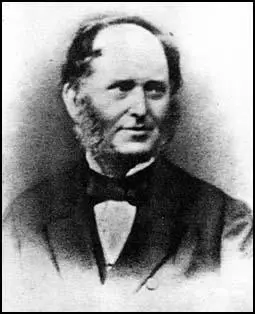 Portrait
of Richard Beard (1801-1885) Portrait
of Richard Beard (1801-1885)
Richard
Beard opened England's first photographic portrait studio
in London on 23rd March 1841 and made a fortune selling daguerreotype
licences.
|
Richard
Beard, a successful coal merchant, and patent speculator,
had seen the advantages of securing a monopoly in the production
of daguerreotype portraits in England. In June 1840, Beard
filed a patent which included the features of Alexander S
Wolcott’s mirror camera which, by drastically reducing
exposure times, would make the production of photographic
portraits more effective. Beard then employed the services
of John Frederick Goddard, a chemist and lecturer in science
who had been experimenting with various chemicals to sensitize
the silvered plates in an effort to accelerate camera exposure
times. Early in 1841, Goddard produced a mixture of iodine
and bromine to increase the sensitivity of the photographic
plates, thereby reducing exposure times to less than a minute
or, in bright sunlight, to a number of seconds. On 23rd March
1841, Richard Beard opened England’s first photographic
portrait studio to the public at the Royal Polytechnic Institution,
309 Regent Street, London. In June 1841, Beard concluded his
negotiations with Miles Berry, Louis Daguerre’s patent
agent in England, and purchased the patent rights to the daguerreotype
process. On 16th July 1841 Beard signed an agreement with
Daguerre and the son of Nicephore Niepce, the man who
had made the first successful photograph from nature in 1826.
|
By
the end of July 1841, Beard had become the sole patentee of the
daguerreotype process in “England, Wales and the town of Berwick
on Tweed, and in all Her Majesty’s Colonies and Plantations
abroad” and had a virtual monopoly in the production of photographic
portraits using Daguerre’s method.
Beard’s
only serious rival in the field of daguerreotype portraiture in
1841 was Antoine Claudet, a French glass
merchant living in London,who had made direct contact with Daguerre
in France and had secured from the inventor a licence to make daguerreotype
portraits in London.
Until
the patent rights of British Patent No 8194 expired on 14th August
1853, any person who wanted to legally carry out the art of daguerreotype
portrait photography on a commercial basis had to apply to Richard
Beard, to either purchase the right of patent in a prescribed geographical
area or to purchase a licence to work the process in a particular
town or city.
England's
First Provincial Photographic Studios
In June 1841, Richard Beard claimed to have “disposed of licences
for Liverpool, Brighton, Bristol, Bath, Cheltenham and Plymouth”.
The first provincial photographic studio in England was opened on
31st July 1841 at Plymouth. A second daguerreotype studio was opened
in Bristol on 10th August 1841. In September, 1841 Photographic
Institutions were established at Cheltenham and Liverpool. On
Saturday 2nd October, Alfred Barber opened a photographic portrait
studio in Nottingham. The proprietors of these new “Photographic
Institutions” required considerable capital. To operate in
the town of Nottingham, Alfred Barber was expected to pay a total
of £1,220, made up of a down payment of £450, a first
instalment of £50, followed by three separate quarterly instalments
of £240. The Licence which covered Liverpool and a ten mile
area around the city was fixed at £2,500.
|
William
Constable's Photographic Institution in Brighton
William
Constable had paid £1,000 to Beard for a licence to
take daguerreotype portraits in Brighton. Constable opened
his Photographic Institution to the public on Monday 8th November
1841. Before
the week was over, Constable wrote to his sister Susanna and
gave a progress report on his new enterprise:
“I opened my concern of business last Monday –
for the first day or two I took but very little money indeed
. . . I could not help feeling anxious and nervous, although
the result was what I reasonably ought to have expected –
But I feel every day that I am growing in notice and have
no doubt that I am gaining a very fast and respectable foothold
here . . . I am crowded with visitors all day – from
11 to 4 . . . there is nothing against me but the lateness
of the season.”
William Constable seated in front of
Cruikshank's 1842 picture of an early daguerreotype studio.
|
1 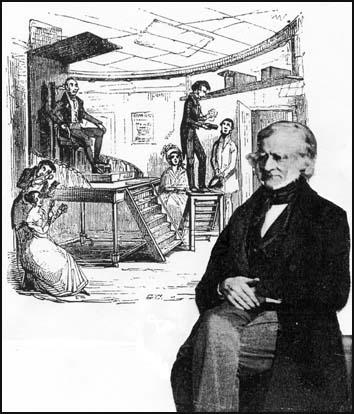 |
Seasonal
Visitors to Brighton
Constable’s phrase ‘the lateness of the season’ could
be assumed to be a reference to the darkening skies of winter, when
an absence of sunshine would lengthen camera exposure times and
affect the quality of his studio portraits, but he was probably
expressing his concern that the season of the year when it was fashionable
to visit Brighton was nearing its end. Twenty years earlier the
aristocracy and the upper classes of society had traditionally visited
Brighton in the summer months of June, July and August. The ‘Brighton
Ambulator’ of 1818 had calculated there were 7000 additional
residents in Brighton during the summer months between June and
October, but from November to February the number of visitors declined
to 2,300. By 1830, the fashionable season had shifted from the summer
to the autumn and winter.
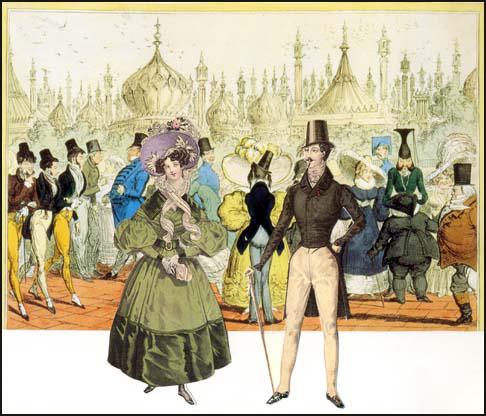
Fashionable Visitors to Brighton.
.
A fashionable couple with Alfred Crowquill's Beauties of Brighton
(1826) in the background.
Even before the railway line from London to Brighton was completed
in September 1841, the ‘New Monthly Magazine’ had
declared :
“the summer months are abandoned to the trading population
of London, the early autumn is surrendered to the lawyers and when
November summons them to Westminster, the ‘beau monde’
commence their migration to encounter the gales of that inclement
season secure from any participation of the pleasure with a plebian
multitude”.
Constable's
Photographic Portraits of Prince Albert and the Nobility
Constable had established his exclusive portrait studio in Brighton
at a time when the nobility and gentry were delaying their visits
to Brighton, restricting their period of stay at this fashionable
seaside resort to the months of November, December and January.
As Edmund M Gilbert commented in his study of Brighton and the growth
of the English seaside resort, the aristocracy found that “residence
in Brighton could be deferred until after the departure of the vulgarians”.
1 ,. ,.
Copy of a daguerreotype portrait
of Prince Albert [1842] Attributed to William Constable's
Photographic Institution. John Counsell, one of Constable's
assistants, claimed to have operated the camera when
Prince Albert sat for his portrait in Brighton on 7th
March, 1842.
|
The
Royal Family chose to visit Brighton even later in the season,
perhaps to avoid the fashionable visitors. Queen Victoria,
her consort Prince Albert, their two young children, Victoria
the Princess Royal and Albert Edward, the Prince of Wales
and members of Court took up residence at the Royal Pavilion
on 10th February 1842. On 25th February, George Anson, Prince
Albert’s Private Secretary, visited Constable’s
Photographic Institution on Marine Parade and had his portrait
taken. Just over a week later, on 5th March 1842, Prince
Albert himself, together with two German cousins, arrived
at Constable’s studio unannounced hoping to have their
portraits taken but, as Constable’s sister Mrs Susanna
Grece later recalled, the day was an "unlucky
one for portrait taking"
and the Prince and his cousins “like others this day
could not get a good picture”.
The
next day, Prince Albert’s German relatives Prince Ferdinand
of Saxe-Coburg and his two sons Prince Augustus and Prince
Leopold sat for their portraits and as later reported in
the Sussex Express “expressed their astonishment at
the rapidity of the process and the fidelity of the likenesses.”
Encouraged
by their response, Prince Albert called in at the Photographic
Institution on the afternoon of 7th March in order to be
photographed. According to the journal of Constable’s
sister, Susanna Grece, Prince Albert posed a number of times
that afternoon, but with limited success. “He had eight
pictures, not all good”. The successful daguerreotypes
were later photographed and two carbon prints have survived.
These two small portraits of Prince Albert, dated 1842 and
attributed to Constable, are believed to be the earliest
surviving photographs of a member of the Royal Family.
|
The
royal visit would have helped to establish William Constable’s
reputation as a photographer to the aristocracy and members of the
Court. Over the next ten years his sitters included the Duke of
Devonshire, the Marchioness of Donegal, Lord Cavendish and the Grand
Duchess of Parma. As Constable noted in 1848 “I have had many
sitters from the ranks that are called noble”.
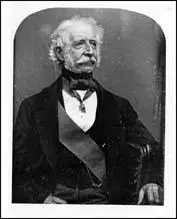
A daguerreotype portrait of Sir Hugh
Gough taken in 1850 by an unknown photographer. Born in
1779, Gough fought with Wellington in the Napoleonic Wars.
|

A portrait miniature of a young officer
by the artist George Engleheart [1750-1829]. When Sir Hugh
Gough ( far left
) was an officer in Wellington's Army in the early
part of the 19th Century, a visit to a portrait painter was
the only way to secure a good likeness. By the time he was
in his early sixties, Gough, like other wealthy men, could
turn to a daguerreotype artist to make a small photographic
portrait.
|
Constable's Successful Photographic Studio
Constable
had been fortunate to secure Royal patronage and his aristocratic
and noble clients saw him safely through his first two years of
business at Marine Parade. However, Constable was an astute businessman
and was prepared to take steps to ensure a steady flow of sitters.
When Constable opened his Photographic Institution in November 1841,
he charged one guinea (£1.1s or 1.05p) for a portrait in a
plain morocco leather case. His prices are comparable to those charged
by other Beard Licencees of the period. Prices in the West End of
London were rather higher. Beard's own Polytechnic Studio in Regent
Street London charged upwards from £1 8s 6d (about £1.42p)
for a small daguerreotype portrait.
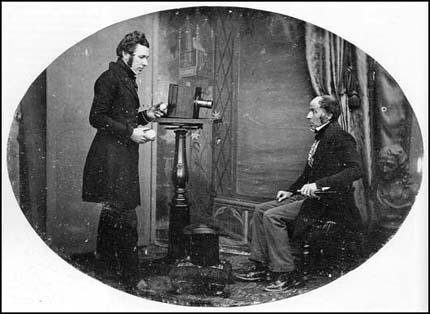
Jabez
Hogg, an operator for Richard Beard, taking a daguerreotype portrait
of Mr Johnson in London (c1842)
Running a Photographic Institution in the 1840s could be lucrative,
but it was a risky business. Within two months of opening to the
public in September 1841, the Liverpool studio had taken 500 portraits.
However, in Nottingham, Alfred Barber had taken only 53 portraits
over a four month period and when he failed to keep up his quarterly
payments, Beard took legal action to close Barber's studio. Constable
feared that the prices he charged his exclusive clientele would
deter other potential customers. By the end of 1843, he had reduced
his price for a cased portrait from £1.1s (£1.05p) to
12s 6d (62p), hoping "to possess himself of the patronage of
the middle classes of the community." A daguerreotype portrait
was still out of the reach of ordinary working people. An unskilled
worker would earn less than 10 shillings (50p.) a week in the 1840s.
However, reducing the price of his daguerreotype portraits meant
that his customer base was widened to embrace wealthy visitors and
Brighton's expanding middle class. The Dukes, Earls, Lords and Ladies
who made up Constable's early clientele were joined by prosperous
merchants, successful businessmen and professional gentlemen together
with their wives and children.The addition of customers drawn from
the middle ranks of society ensured that Constable had no shortage
of sitters in the late 1840s.
William Constable is known to have employed operators at his Photographic
Institution on Marine Parade from the very beginning.Constable's
sister, Mrs Susanna Grece, mentions in her journal that her brother
employed at least two assistants in 1842. John Counsell,
who later became a daguerreotypist in Edinburgh and Cornwall, claimed
to have made the portraits of Prince Albert and the Duke of Saxe
Coburg at Constable's Marine Parade studio in March 1842. The photographic
artist James Thomas Foard, who went on to manage Beard's
Liverpool studio in 1849, had worked for William Constable five
years earlier.
Very few of the original proprietors of the provincial Photographic
Institutions licensed by Beard stayed in business for very long.
The Photographic Rooms in the Horticultural Gardens of Bristol changed
hands at least 3 times between 1841 and 1848. John Palmer, an early
Beard licensee, vacated the Cheltenham Photographic Institution
in 1844 after only 3 years. In contrast, William Constable remained
in business as a Photographic Artist in Brighton for 20 years from
November 1841 until his death in December 1861.
Section
B: Daguerreotype and Talbotype; Early Photographic Artists in Brighton
[1851-1854]
DAGUERREOTYPE PORTRAIT STUDIOS IN BRIGHTON
Holding an exclusive licence from Richard Beard, William Constable
had a virtual monopoly in the production of photographic portraits
in Brighton between November 1841 and 1851. In the Census of 1851,
the only other photographer recorded in Brighton was nineteen year
old Thomas B.Leffin, who was presumably an assistant to William
Constable. The 1851 Census describes Constable as "Flour
Manufacturer and Heliographic Artist ", a widower aged 67,
living with two nieces, Caroline and Eliza Constable,
who probably provided assistance in his photographic business. After
William Constable died in December 1861, a Miss Constable continued
to run his studio at 58 King's Road.
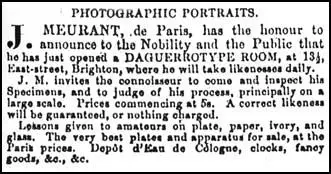
Advertisement
for Joseph Meurant's Daguerreotype Room (Brighton Herald
7August 1852)
At least on one occasion, a daguerreotype artist felt confident
enough to challenge Constable's monopoly in the production of daguerreotype
portraits in the town . In the Summer of 1852, a rival to Constable
appeared in the form of a French daguerreotype artist, Joseph
Meurant from Paris. In July 1852, Meurant announced in the
'Brighton Herald' that he had opened a Daguerreotype Room at 131/2
East Street, where he offered to take likenesses for as little as
5 shillings. Meurant remained in Brighton for less than nine months
before moving on to London. [Shortly after Beard's patent on the
daguerreotype expired in 1853, Meurant established a photographic
studio at Newington Butts in South London.]
EARLY PHOTOGRAPHIC VIEWS OF BRIGHTON
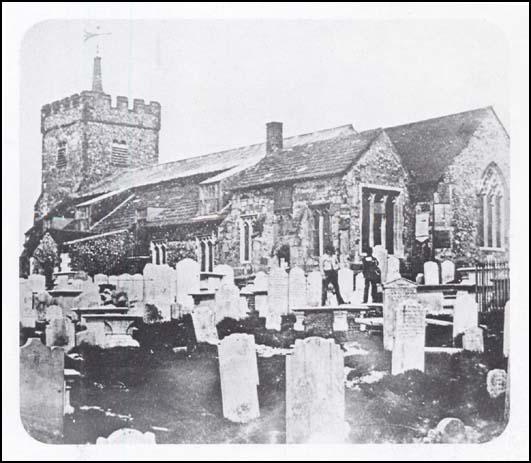
St
Nicholas' Church (c1850). A daguerreotype by George Ruff senior
Before the arrival of Meurant in 1852, there is no record of any
professional portrait photographers in Brighton who could compete
against William Constable. However, there is evidence that there
were other "photographic artists" making daguerreotypes
and early photographic views of Brighton between 1850 and 1852.
George Ruff, described as a 24 year old "painter in
oil and watercolour" in the 1851 Census, was using daguerreotype
apparatus to capture local views and buildings around this time.
George Ruff, who painted landscapes and marine scenes, made a daguerreotype
of Brighton's St Nicholas Church around 1850 and it is likely he
made other daguerreotypes, either as an aid to his landscape painting
or as 'works of art' in their own right. Edward Fox junior, who
specialised in landscape photography, was the son of a London born
waterolour artist who had settled in Brighton around 1820. Edward
Fox junior, also described himself as an artist and in the 1850s
he earned his living as a decorative painter and designer. By the
early 1860s, Fox was advertising his landscape photography and in
his later advertisements mentions that he had "given his whole
attention to Out-door Photography since 1851." Edward Fox was
based at 44 Market Street and a photograph believed to date from
around 1851 shows the neighbouring shops at Nos 42 and 43 Market
Street.
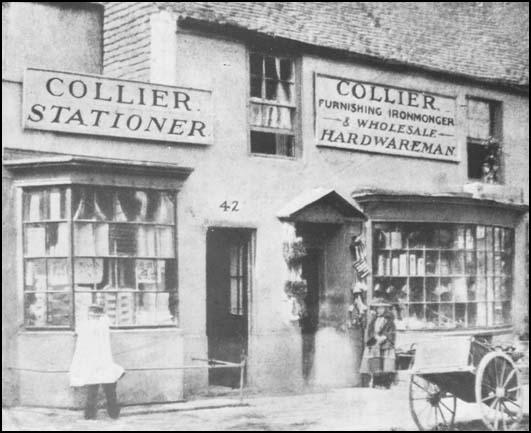
Numbers
42 and 43 Market Street, Brighton (c1851). The photographer is not
named, but Edward Fox junior, lived at 44 Market Street and was
taking photographic views of Brighton as early as 1851.
DAGUERREOTYPE ARTISTS IN BRIGHTON AFTER 1853
After Beard's Daguerreotype Patent expired in August 1853, a number
of Brighton trades people, who had already shown an interest in
the art of photography, set up their own daguerreotype portrait
studios.As early as 1852, William Lane, proprietor of 'Lane's
Cheap Picture Frame Manufactory', established a Photographic Depot
at 3 Market Street, Brighton where he supplied "Daguerreotype
Lenses, Camera Apparatus" and "every other requisite used
in Photography." A complete set of apparatus for the daguerreotype
process cost 7 guineas at Lanes' Depot.In an advertisement which
appeared eight days before Beard's daguerreotype patent was due
to expire, William Lane was offering to supply 'Daguerreotype Apparatus'
to operators and amateurs promising free instruction in the Photographer's
Art to purchasers of materials. By November 1853, Lane had set himself
up as a photographic artist and was offering to provide "a
first class daguerreotype portrait in handsome French case for two
shillings" at his new premises at 213 Western Road.
Robert Farmer, who had taken over William Passmore's Chemist's
shop at 59 North Street in 1852, transformed part of his new business
premises into Daguerreotype Rooms - which included "a room
designed and built expressly with apparatus of very superior construction
for the purpose . . . to ensure a fine portrait." In newspapers
issued in November 1853, Robert Farmer publicized his Daguerreotype
Rooms and "invited the attention of the Ladies, Gentlemen and
Visitors to Brighton to his collection of Photographic Portraits,
taken plain or in colours, by competent Artists". Mr Farmer
offered to take "fine portraits" at moderate prices -
"1s 6d in case; or coloured 2s 6d" which would have been
considerably lower than those charged by William Constable's Original
Photographic Institution in Marine Parade.
The Talbotype - an alternative to the Daguerreotype
in Brighton
In 1839, the same year that Daguerre announced his method of fixing
images on a silvered copper plate, William
Henry Fox Talbot,
an English landowner, scholar and scientist published 'The Art of
Photogenic Drawing', an account of how he had managed to capture
images permanently on paper. Four years earlier, Talbot had produced
tiny photographic views of Lacock Abbey, his home in Wiltshire.
By treating the small pictures with wax, Talbot was able to use
them as negatives and print further copies. Although he had invented
a negative/positive photographic process, Talbot's early pictures
were small, required very long exposure times and lacked the sharpness
of detail and brilliance of the daguerreotype. Talbot continued
his experiments and improved the quality of his photographs by coating
his paper with silver iodide and developing the images with a gallo-nitrate
of silver solution. Talbot patented his new process in February
1841, describing his pictures as 'Calotypes'. Talbot protected his
photographic inventions by filing a number of all-embracing patents.
Under pressure from the Royal Academy and the Royal Society, Talbot
had, in August 1852, relaxed his control over the production of
calotypes, allowing amateurs and artists to use the process,
but he insisted that all professional photographers who wanted to
use his calotype process for taking portraits had to purchase a
licence, which usually involved an annual fee of between £100
and £150.
In 1852, Thomas Henry Hennah, a young London artist, together
with William Henry Kent, a photographic artist from the Isle
of Wight, purchased a licence from William Fox Talbot to make portraits
using the calotype process. The photographic prints were called
'Talbotypes' in honour of the inventor. By 1854, Hennah and Kent
had established a Talbotype Portrait Gallery in William Henry
Mason's Repository of Arts at 108 King's Road, Brighton.An
item in the 'Brighton Gazette' of 12th October 1854 indicates that
the Talbotype Gallery specialised in taking portraits of the nobility
and the upper ranks of society. The 'Brighton Gazette' enumerates
"a few of the distinguished persons who have recently honoured
these eminently skilful artists with a sitting", listing the
Duke of Devonshire, Countess Granville, Lord Carnworth, Lady Keats
and several other notable visitors to Brighton. Hennah & Kent
came into direct competition with William Constable who in July
1854 joined forces with another daguerreotype artist, Edward
Collier at 58 Kings Road to form the firm of Constable &
Collier.
Robert Farmer, who made his living mainly from taking daguerreotype
portraits, placed advertisements during November and December of
1853, which drew attention to his "Calotype views of the Pavilion,
The Railway Terminus etc taken by Gustave Le Gray's new waxed paper
process." [Farmer's advertisement would have annoyed William
Fox Talbot who claimed Le Gray's waxed paper process was an infringement
of his patent of 1843.]
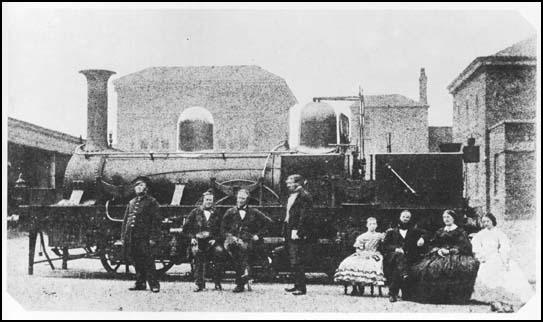
Craven's
Locomotive No12 with John Chester Craven,his family and staff at
Lover's Walk,Brighton (May 1858) A talbotype had less detail than
a daguerreotype and the print often had a fuzzy and mottled appearance.
Stephen Grey and William Hall, who established their
General Photographic Institution at 13 St James Street in the summer
of 1854, offered to take portraits "by all the most recent
and improved processes by 'Licence of the Patentees'. Large sized
Talbotype portraits mounted in a gilt frame were offered at 15 shillings
(75p), while daguerreotype portraits were priced from 6 shillings
(30p).
Amateurs and artists who wished to use Talbot's invention could
turn to Lewis Dixey, optician and mathematical instrument
maker of 21 Kings Road, Brighton, who supplied "every description
of photographic apparatus for the Calotype" and iodized paper
for the Talbotype.
PART
2: PHOTOGRAPHS ON GLASS AND PAPER [ 1854 - 1860 ]
Section
A : The Collodion Process
and Photographs on Glass
In
March 1851, Frederick Scott Archer, a sculptor and a member
of the Calotype Photographic Club, published details of his "wet
collodion process", which involved coating a glass plate
with a mixture of potassium iodide and a sticky substance called
collodion. Also known as "gun cotton", collodion was a
transparent and adhesive material that was first used in surgery
to dress wounds. The coated glass plate was then sensitized in a
bath of silver nitrate. The highly sensitive wet plate was then
placed inside a camera and exposed by uncapping the lens. Earlier
methods using glass plates coated with albumen (egg white) provided
exposure times of between five to fifteen minutes and so were unsuitable
for portrait photography. Archer's "wet collodion" process
could produced high quality negatives after exposures of only a
few seconds. Unlike Beard with the daguerreotype process and Talbot
with the 'calotype', Archer chose not to patent his discovery and
offered his invention free to all photographers.
Collodion
Positives - Cheap Portraits on Glass
Frederick Scott Archer's collodion 'wet plate' process produced
a glass negative which could make an unlimited number of prints
on paper. However, most customers were seeking a cheap alternative
to the handsome daguerreotype portrait, which came protected under
glass in a metal frame and presented in a velvet-lined, leather-bound
display case. Scott Archer soon realised that by underexposing the
collodion glass negative and placing it on a black background, the
image took on the appearance of a positive picture.The resulting
image was as sharp and clear as a daguerreotype, yet Archer's new
process was cheaper and less complicated. Furthermore, the collodion
positive process was incredibly quick to perform. Photographers
could see immediately the commercial possibilities of a cheap and
speedy method of taking portraits. The "collodion positive"
photograph on glass could be backed with black paper, very dark
varnish or provided with a background of black velvet or similar
dark cloth. Protected by glass, placed in a metal frame and inserted
in a presentation case or an elaborate frame, the collodion positive
was an inexpensive substitute for the daguerreotype portrait, which
in the 1840s had been the preserve of the nobility and the wealthy
middle classes of society.
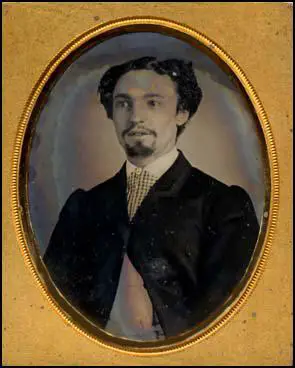 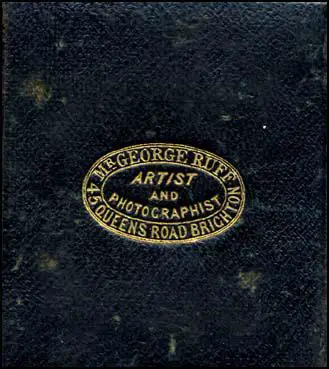
A
Portrait of a Bearded Man. A collodion positive photograph on glass
taken by George Ruff senior (c1858). The presentation case is similar
to the ones that held daguerreotype portraits.
William Lane of Brighton was promoting the new process of making
"portraits and views taken on glass" as early as September
1852. In an advertisement placed in The Times, dated 10th September
1852, Lane claimed that "any person can produce in a few seconds,
at a trifling expense, truly life-like portraits."Early
in 1853, William Lane's Cheap Photographic Depot was offering a
"complete set of apparatus for the glass or paper process"
for the sum of 4 guineas (£4. 4s/£4.20p). By October
1853, The Royal Chain Pier Photographic Rooms in Brighton
were advertising "Portraits superior to engravings by the new
process on glass."
On 3rd August 1854, Grey & Hall's Photographic Institution
on St James Street announced they had "completed arrangements
for taking portraits by all the most recent and improved processes,
by License of the Patentees". In addition to Talbotype portraits
and "Daguerreotypes warranted to last," Grey and Hall
offered to make "Coloured Collodion Positives by a new
and peculiar process" for the sum of 15 shillings (75p).
Stephen Grey and William Hall were keen to emphasize
that their new methods of taking portraits were "licensed by
the Patentees". Archer had not patented his invention and Beard's
daguerreotype patent had expired the year before, but William Henry
Fox Talbot claimed that the "collodion process" was covered
by his earlier patent which had described a negative/positive system
of photography.
In 1854, W.H.Fox Talbot took legal action against the studio of
Silvester Laroche,the professional name of Martin Laroche, a London
photographer who had started to use Archer's "wet collodion"
technique in 1853. Silvester Laroche went to court to defend his
right to use the "wet plate" process. In December 1854,
Laroche was found not guilty of infringing Talbot's patent rights
and as a result of this legal judgement all photography was now
free from restriction.
In the summer of 1855, James Henderson, a photographic artist
who had previously operated portrait studios in London's Strand
and Regent Street, opened a photographic studio at No 5, Colonnade
in New Road, Brighton. In an advertisement dated 4th August 1855,
James Henderson offered to take "Photographic Portraits, on
Paper, Silver, and Glass Plates . . . Prices from 10s 6d and upwards."
In this newspaper advertisement, Henderson "begs to remind
all lovers of Photography that he has been at considerable expense
in defending the freedom of this beautiful art against Mr Fox Talbot,
the Patentee of the Talbotype process." Earlier, in May 1854,
Talbot had obtained an injunction which restrained Henderson from
making and selling photographic portraits by the collodion process.
Laroche's successful defence against Talbot's legal action meant
that Henderson and other photographers in Brighton were free to
produce portraits using any of the main photographic processes.
Section
B : A Variety of Photographerss
The
Artist - Photographer
The earliest photographer in Brighton, William Constable
had, before turning to photography, received some attention for
his artistic talent in drawing and painting. During his travels
in America, Constable made sketches of Niagara Falls and other
striking features of the New World, which he later made into finished
watercolours. A contemporary newspaper The Brightron Herald
described Constable's artwork as "eminently fresh, graphic
and original". Modern commentators on Constable's photographs
draw particular attention to their artistic quality.
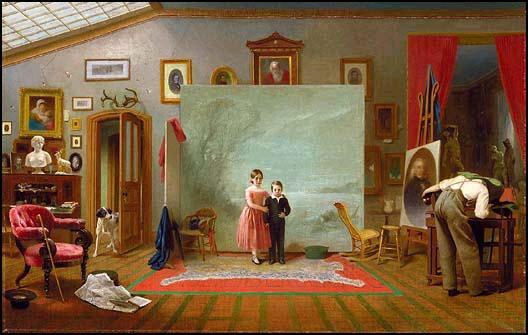
An
artist turns to the art of photography.[ Interior with
Portraits (c1865) by the American artist Thomas Le Clear]
SMITHSONIAN INSTITUTE
Many
of Brighton's early photographers had an artistic background.
George Ruff gave his occupation as "Painter in Oil
and Water Colours" in the 1851 Census and as an artist, exhibited
marine and landscape paintings before he set up his photographic
studio in Brighton's Queens Road. Edward Fox junior was
described as a "decorative painter" in the census and
Jesse Harris, who was describedl as a daguerreotype artist
in 1854, is recorded in the 1851 Census as "Artist-Painter".
Stephen Grey, who joined with William Hall to form the
photographic firm of Grey & Hall in 1854, is listed
as a portrait painter in an 1852 directory. Thomas H. Hennah,
a partner in the Hennah & Kent photographic studio,
gave his profession as "artist" to the census enumerator.
Chemists
and Opticians
Photography has its technical as well as artistic aspects. The
early photographic processes were complicated and required the
agency of chemicals and so it is not surprising that an early
Brighton photographer was the chemist Robert Farmer, who
had come to Brighton in 1852 to take over William S. Passmore's
chemist's shop at 59 North Street. Photography also involves optics
and the employment of lenses and so Lewis Dixey, optician
and mathematical instrument maker of Kings Road, Brighton was
well placed to provide photographic apparatus and by 1854 he was
also listed as a daguerreotype artist.
Carvers,
Gilders and Picture Frame Makers
It was perhaps natural for carvers, gilders and picture frame
makers to become involved in the new art of photography. William
G. Smith who became a photographic artist in the mid 1850s
was a carver and gilder residing in Western Road Brighton at the
time of the 1851 Census. William Lane had owned the 'Cheap
Picture Frame Manufactory' at 3 Market Street, near Castle Square,
Brighton, where he mounted and framed paintings, engravings and
water colour drawings. As early as 1852, Lane had added to his
picture framing business a Photographic Apparatus Depot. William
Lane described himself as a photographer in 1852, but he had few
artistic pretensions. He took a more practical approach than photographic
artists such as Constable, Fox, Harris, Hennah and Ruff. According
to William Lane's 1852 advertisement, artistic talent was not
a prerequisite for accomplished photography."No knowledge
of drawing required to produce these wondrous works of art and
beauty... By this new process any person can produce in a few
seconds (at a trifling expense) truly life-like portraits of their
friends, landscapes, views, buildings etc". Lane offered
to provide "printed instructions, containing full particulars
for practising this fascinating art with ease and certainty".
Artisans
and Tradesmen
William
Lane was happy to supply daguerreotype apparatus and materials
to operators or amateurs, providing "instructions in the
Photographic Art" free of charge to all purchasers of photographic
equipment.
By the late 1850s, tradesmen with no previous interest in art
or photography had set themselves up as photographic artists.
Possibly armed with apparatus and instructions from Wiliam Lane's
Photographic Depot or some other local supplier, two brothers
Charles and John Combes, established themselves as "daguerreotypers"
at 62 St James Street, Brighton in 1854. In 1851, Charles Combes
was employed as a warehouseman and his younger brother John was
learning shoemaking from his cordwainer father. The Combes brothers
obviously believed they could improve their fortunes by entering
a potentially lucrative business.
James
Waggett, was earning a living manufacturing and tuning pianofortes,
when he decided to offer the additional service of taking photographic
portraits. After 3 years or so, James Waggett was removed from
the list of Brighton photographic artists and appeared once more
under the heading 'pianoforte tuners' in the local trades directory.
The chosen trade of James R Bates was that of fruiterer
and seedsman. As a 23 year old, he was running a fruiterer's shop
in Brighton and forty years later he was still in the same business.
Yet, for at least a year from 1858 to 1859, James R Bates tried
his hand at photography. When the expected profits did not materialise,
Bates abandoned photography and returned to selling fruit, seeds
and flowers.
Entrepreneurs
Joseph Langridge was a true entrepreneur. Langridge was
prepared to invest in any sort of scheme and ready to carry out
any trade to make money, and he eventually realised that taking
photographic portraits was as good a way as any. In his twenties,
Joseph Langridge, the son of a pawnbroker and second hand clothes
dealer, borrowed heavily to purchase railway shares, and invest
in a jewellery business. He carried on as a jeweller in Brighton
until the late 1840s when he started a bakery business in London.
Langridge was an insolvent debtor in 1842 and nine years later,
after his bakery venture failed, he was again declared insolvent
and sentenced to 10 months imprisonment for not paying off his
debts. On his release from prison, Langridge tried his hand at
manufacturing soda water and, by 1853, he was selling smoked and
salted herrings as 'Brighton bloaters'. Listed as a photographer
at 43 Clarence Square Brighton in 1858, Joseph Langridge was probably
the man behind the photographic firm of Merrick & Co,
which appeared at 186 Western Road in 1856. Under the studio name
of Merrick, Joseph Langridge continued as a photographic artist
in Brighton for another sixteen years.
Emigres,
Exiles and Foreign Professors
Mrs
Agnes Ruge has the distinction of being the first woman to
be recorded as a photographer in Brighton. Madame Ruge is listed
at 180 Western Road under the heading of Daguerreotype Artists
in W J Taylor's 1854 Directory of Brighton. Agnes Ruge, who was
born in Dresden, Saxony, arrived in England in 1850 and was one
of several emigres who practised photography in Brighton. Joseph
Meurant, who was originally from Paris, had opened a Daguerreotype
Room In East Street, Brighton in July 1852.
Agnes
Ruge was the wife of Professor Arnold Ruge (1802-1880), an associate
of Karl Marx and a radical, who had been driven into political
exile after the failure of the 1848 Revolution in Germany.Mrs
Ruge worked as a daguerreotype artist for only a short period
of time. By 1857, Agnes Ruge was earning a living as a teacher
of the German language. Karl Marx wrote in November 1857 that
"Mrs Ruge is the only teacher of German in Brighton"
and added that "so greatly does demand exceed supply,"
she had to recruit her 19 year old daughter,Hedwig, as an assistant.
In
1851, Sarah Lowenthal was described as a "Preceptress",
or teacher, at a Ladies' School in Brighton. Mrs Lowenthal was
the English wife of Nathan Lowenthal, a Prussian immigrant , who,
in the 1851 Census, gave his occupation as "Professor of
Languages." In 1856, Mrs Sarah Lowenthal is listed in a local
directory as a "Talbotype Portrait Colourer" based at
Lonsdale House, College Road, Brighton.
High Street Photographers from London
PART
3 : THE GROWTH OF PHOTOGRAPHIC STUDIOS IN BRIGHTON ( 1854-1861
)
Photographic
Portrait Studios
In the ten years between November 1841 and November 1851, William
Constable, aided by a few assistants, was the only photographic
artist operating a portrait studio in Brighton.
When W.J.Taylor's Original Directory of Brighton was compiled
for the year 1854, ten photographic studios were listed :
Edward COLLIER 58, King's Road
Charles and John COMBES 62, St James's Street
William CONSTABLE 57, Marine Parade
Lewis DIXEY 21, King's Road
Robert FARMER 59 & 114 North Street
GREY & HALL 13, St James's Street
Jesse HARRIS 213, Western Road
HENNAH & KENT 108, King's Road
William LANE 213, Western Road
Madame Agnes RUGE 180 Western Road
All the photographers listed in Taylor's 1854 directory appeared
under the heading 'ARTISTS - Daguerreotype', yet we know Hennah
& Kent specialised in talbotypes, Lewis Dixey stocked
photographic apparatus for the calotype and collodion processes,
Farmer produced calotypes using a waxed paper process and Grey
& Hall employed "three distinct processes" - talbotype
and collodion as well as daguerreotype.
To the 10 studios listed by Taylor's Directory in 1854 we can
add the names of the artists Edward Fox junior and George
Ruff, both of whom were using a camera to make views of Brighton
in the early 1850s.
William Constable, who for 10 years had enjoyed a monopoly
in the production of photographic portraits, was now faced with
up to a dozen competitors. In the summer of 1854, Constable closed
his original studio at 57 Marine Parade and removed his photographic
business to the Old Custom House at 58 King's Road, where he joined
forces with the daguerreotype artist Edward Collier. The
Partnership of Constable & Collier continued for about
3 years. By 1858, William Constable was listed as the sole proprietor
of the Original Photographic Institution at 58 Kings' Road.
In June 1855, the Brighton and Sussex Photographic Society
was formed. The Photographic Society held monthly meetings and
was open to amateurs and professionals. An amateur, the Reverend
Watson acted as chairman, while the post of Honorary Secretary
was held by Constable's business partner and professional daguerreotype
artist Edward Collier. By September 1855, the Photographic Society
boasted 40 members.
James Henderson, a well known London daguerreotype artist,
arrived in Brighton in the summer of 1855, but by September he
had moved on to Cornwall, to establish a portrait studio in Launceston.
Henderson may have been deterred by the number of photographers
already active in Brighton. Folthorp's Brighton Directory, which
had been corrected to September 1856, adds three more photographic
studios not listed in Taylor's earlier directory. George Ruff,
who had been taking daguerreotype since around 1850, finally presented
himself as a professional photograher in 1856. Also listed in
1856 was the firm of Merrick & Co and James
Waggett, who had previously operated as a manufacturer
and tuner of pianofortes at 193 Western Road. Photographic artists
were listed in the section on Professions and Trades in Brighton
directories, but these listings do not provide a complete picture.
William G Smith is described as a photographic artist in
the 1856 street directory, but his name does not appear as a photographer
in the 'professions and trades' directory. William Lane,
an important name in the early history of photography in Brighton,
is not listed in Folthorp's Directory of 1856, yet newspaper advertisements
from this time show that William Lane was employing two other
operators, Mr Davis and Mr Warner, and in addition to his main
studio at 213 Western Road, Lane had a branch studio in Shoreham.
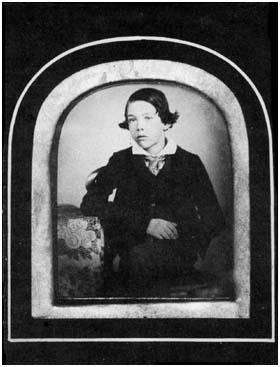 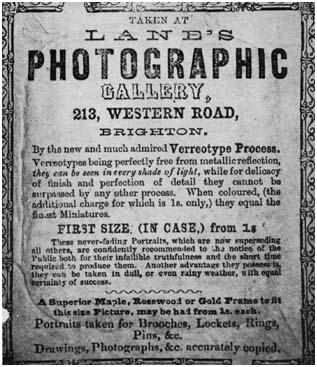
Portrait
of a Boy (c1855). "Verreotype" portrait taken at Lane's
Photographic Gallery, 213 Western Road. William Lane called his
collodion positives "verreotypes". In America they were
known as "ambrotypes".
The
Decline of the Daguerreotype
By the time Folthorp's Directory of 1856 was published, the daguerreotype
was on its way out. All the photographers listed in the Professional
and Trades section of Folthorp's Directory appear under the heading
Photographic and Talbotype Galleries. 'Farmer's Daguerreotype
Rooms' had become 'Farmer's Photographic Institution' and William
Lane had abandoned the daguerreotype for his Verreotype process.
In an advertisement dated 3 January 1856, William Lane
promoted his new and improved Verreotype Process, by detailing
the advantages the new process had over the daguerreotype. Verreotypes,
Lane proclaimed, were perfectly free from metallic reflection
and could be seen "in every shade of light." Verreotype
portraits took only a short time to produce and could be "taken
in dull, or even rainy weather . . . when it would be quite impossible
to operate with the Daguerreotype method." Lane states confidently
in his advertisement that "these never fading Portraits .
. . are now superseding Daguerreotypes."
Stereoscopic
Photographs
In
1838, the English scientist and inventor Sir Charles Wheatstone
(1802-1875) had described the phenomena of binocular vision and
designed apparatus which fused two separate drawings into a single
three dimensional image. To describe this viewing instrument,
Wheatstone coined the term "Stereoscope" (from the Greek
words 'stereos' meaning "solid" and 'skopein' meaning
"to look at") With the advent of photography, Wheatstone's
reflecting stereoscope, which utilised mirrors, could be used
to view a pair of almost identical photographs and give the illusion
of depth.
Sir David Brewster (1781-1868), a Scottish physicist, designed
a stereoscope that employed two lenses which mimicked binocular
vision. Jules Duboscq (1817-1886) a Parisian optician constructed
an improved stereoscope based on Brewster's design, which merged
two photographs of the same subject to form a three-dimensional
picture.
At the Great Exhibition of 1851, Queen Victoria was particularly
impressed by Duboscq's stereoscope and the accompanying stereoscopic
photographs. Queen Victoria's interest in the stereoscope
signalled the start of a popular demand for stereoscope viewers
and stereoscopic photographs. In 1856, Brewster reported over
half a million of his stereoscopes had been sold.
A few stereoscopic talbotypes had been made for Wheatstone soon
after the introduction of photography in 1839. In the early 1850s,
however, most of the early stereoscopic photographs were daguerreotypes.
Duboscq had displayed a set of his own stereoscopic daguerreotypes
at the Great Exhibition of 1851. In 1853, Antoine Claudet
patented a folding stereoscope which could view stereo daguerreotypes.
A couple of years after the Great Exhibition of 1851 stereoscopic
photography arrived in Brighton. In 1853, Thomas Rowley,
Optician to the Sussex and Brighton Eye Infirmary, was advertising
his "superior selection of stereoscopes with Daguerreotype
plates, Collodion and Photographic Pictures" which could
be hired from his premises at 12 St James Street. In November
1853, Robert Farmer of the Daguerreotype Rooms, 59 North
Street was offering to provide a "stereoscopic Portrait,
with Stereoscope, 10s 6d, complete." Lewis Dixey,
Optician and Dealer in Photographic Apparatus, announced in 1854
that he could supply "Stereoscopes & Stereoscopic subjects
in Calotype, Daguerreotype & Collodion or Glass." George
Ruff of 45 Queens Road, Brighton specialised in stereoscopic
portraits in colour.
Stereo Cards
The reflective surface of a silvered copper plate was not ideal
for stereoscopic effects and the process did not lend itself to
the manufacture of large quantities of stereo pictures. With the
advent of the collodion glass negative and photographic prints
on albumenized paper in the mid 1850s, the mass production of
stereo cards became possible.
The London Stereoscopic Company, founded in 1854 by George
Swan Nottage, was a firm that specialized in the mass production
of stereoscopic photographs. Nottage's company responded to the
enormous demand for stereoscopes and stereo cards. By 1856, The
London Stereoscopic Company had sold over 500,000 stereoscopes
and had 10,000 titles in its trade list of stereo cards. Two years
later, in 1858, The London Stereoscopic Company claimed to have
100,000 stereo cards in stock [ George Swan Nottage (1823-1885)
had connections with Brighton. He owned property in the town and
was a regular visitor to Brighton. At the time of the 1861 Census
George Swan Nottage was residing at 15 Marine Parade, Brighton
and when he died in April 1885, he had just returned from an Easter
holiday at the seaside town.]
In 1857, The Brighton Stereoscopic Company based at 121
St James Street, near the Old Steine was selling stereoscopes
from half a crown (2s 6d/121/2 p) and stereoscopic views were
on sale at a shilling (1s/10 p) each.
The fashion for collecting and viewing stereoscopic photographs
reached its peak in the early 1860s. In 1862 alone, The London
Stereoscopic Company had sold a milliion stereoscopic views.
A wide variety of stereoscopic images could be purchased - views
of faraway places, (Japan, The Andes) scenes of everyday life,
anecdotal pictures, humorous tableaux scenes, 'still life' arrangements
and pictures of life in town and country.In 1858, Samuel Fry,
a photographic artist based at 79 Kings Road, Brighton,even produced
a "Stereograph of the Moon"
Some of the stereoscopic views sold in Brighton were of purely
local interest.
In March 1863, William Cornish junior of 109 Kings Road,
Brighton was advertising a set of six stereoscopic photographs
of a decorated railway shed. The 531 ft. long railway shed was
used to house 7,000 school children who had gathered for a meal
to celebrate the marriage of Edward, Prince of Wales and Princess
Alexandra of Denmark. Stereoscopic views of the decorated railway
shed could be purchased singly for one shilling (10 pence) or
the customer could buy a complete set for 6 shillings
William Mason junior, the son of W.H.Mason, printseller
and proprietor of the Repository of Arts in Brighton's Kings Road,
photographed scenes featuring local craftspeople, such as basketmakers,
and issued them as stereographic cards.
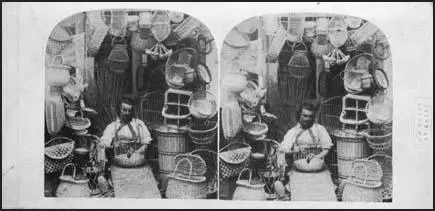
Stereocard
of a Brighton Basketmaker by W H Mason junior (c1862)
More typically, the Brighton artist Edward Fox, who specialised
in landscape photography, advertised "local views as stereoscopic
slides." Familiar landmarks in Brighton, such as the Royal
Chain Pier and the Royal Pavilion became popular subjects for
stereo cards.Some of Edward Fox junior's stereoscopic slides featured
particularly dramatic scenes. Fox's titles included " The
Chain Pier During a Gale " and " Chain Pier by Moonlight".
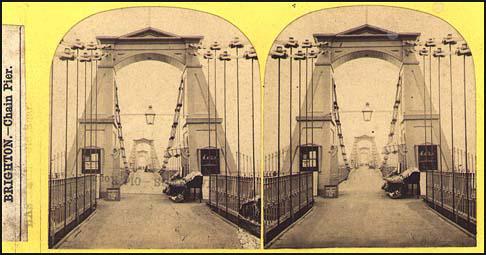
Stereocard of the Chain
Pier, Brighton c1870
Albumen in Photography
Albumen is a clear,organic material found in its purest form in
the white of an egg. Smooth, transparent and sticky, albumen was
seen as a suitable binder in photography. In 1847, the French
army officer and chemist Abel Niepce de Saint-Victor (1805-1870),coated
glass plates with egg-white mixed with potassium iodide and then
sensitized the dried plates in a bath of silver nitrate. The albumen-coated
glass plates made fine, photographic negatives, but exposure times
ranged from five to fifteen minutes and so were only really suitable
for photographing landscapes or buildings. Albumen glass negatives
were soon superseded by Fred Scott Archer's collodion glass negatives.
The Albumen Print
In 1850, L. D. Blanquart-Evrard (1802-1872), a French photographer,
introduced albumenized paper for photographic prints. Albumen
from the white of an egg was mixed with sodium chloride. Sheets
of thin paper were coated with the albumen mixture and then sensitized
with silver nitrate. A collodion glass negative could produce
finely detailed photographs on albumenized paper. By the 1860s,
most photographers were using collodion glass negatives and albumenized
paper in the production of photographic prints.
Blanquart-Evrard exhibited his albumen prints at the Great Exhibition
of 1851, announcing that his new process made it "possible
to produce two or three hundred prints from the same negative
the same day." The albumen print became an essential
component for the mass production of photographic images and played
an important part in meeting the public demand for stereographic
cards and carte de visite portraits in the 1860s.
Outdoor Photography
When Joseph Nicephore Niepce created the earliest surviving
photograph in 1826, the materials he used were so insensitive
it took 8 hours of sunlight for the image to be fixed on the pewter
plate he had prepared. Niepce's heliograph ('sun drawing') was
a view of his courtyard, taken from a top floor window. In 1839,
when photography was first introduced to the world, camera exposure
times ranged from five to fifteen minutes and so the only suitable
subjects were buildings, landscapes and arrangements of still
life. The majority of the pictures made by L.J.M.Daguerre himself
are of buildings and views in Paris.
Artists and amateurs may have been content to use the new invention
to produce a pleasing landscape or record an interesting building,
but astute businessmen knew that financial reward and commercial
success would lie in portrait photography. Every effort had been
made to reduce camera exposure times so that the daguerreotype
process could be used to make portraits. By the early 1840s technical
advances in photography meant that a sitter would only have to
hold a pose for a number of seconds rather than a number of minutes.
When Richard Beard, the patentee of the daguerreotype process
in England and Wales, sold licences authorising the setting up
of 'Photographic Institutions' in provincial towns, the purchasers
were mainly interested in using the invention to "take likenesses."
Outdoor Photography in Brighton Before
1854
The journalist who in November 1841 welcomed the opening of William
Constable's 'Photographic Institution' on Marine Parade in the
pages of the Brighton Guardian, recognised that the main purpose
of photography was to secure "a correct likeness without
the tedium of sitting for hours to an artist."
William Constable made his living from taking "likenesses",
charging his customers one guinea for "a portrait in a plain
morocco case", but it is known that he occasionally took
his camera on to the streets of Brighton. In the 1840s, Constable
took views of fashionable houses in Kemp Town, and two daguerreotypes
of houses in Lewes Crescent ended up in the photograph collection
of Richard Dykes Alexander.
In the early 1850s, local artists Edward Fox junior and
George Ruff senior were taking photographs of buildings
in Brighton. Ruff made a daguerreotype of St Nicholas Church around
1850 and Edward Fox, who declared in later advertisements that
he had "given his whole attention to Out-Door Photography
since 1851", produced pictures of shop fronts, churches and
other public buildings in Brighton and the surrounding area. In
1853, Robert Farmer, proprietor of the 'Daguerreotype Rooms'
in North Street, Brighton was exhibiting his calotype views of
the Royal Pavilion and the Railway Terminus and daguerreotype
views of Brighton's oldest church.
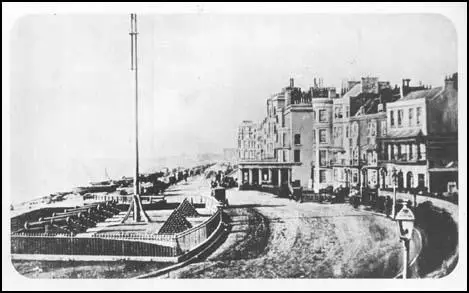
The
West Battery, Kings Road (c1850)
Outdoor Photography in Brighton 1855-1862
With the advent of the collodion process, more and more photographers
in Brighton were taking their cameras out on the street to record
life in the town.
Old buildings and structures scheduled for demolition were a favourite
subject for photographers, who were anxious to record them for
posterity. For example, a battery of eight guns was established
in Brighton's West Cliff in the 1790s to protect the town from
French attacks by sea. In 1857, it was decided to remove the West
Battery so that Brighton's main thoroughfare, the King's Road,
could be widened. Work commenced in January 1858 and from this
date a series of photographs recorded the progress of the dismantling
of the battery and the breaking up of the artillery ground.
In 1862, a row of old houses and shops that ran from 41 to 43
North Street, was scheduled for demolition. A set of oval shaped
photographs recorded the shop fronts and the rear ends of the
buildings that were to be demolished. It is not clear exactly
why these photographs were commissioned, but they allow us to
glimpse not only a vanished parade of Victorian shops, but also
a few bystanders, some of whom would not have been able to afford
the services of a photographer. Another gorup of workers whose
wages probably would not stretch to pay for a sitting at the professional
portrait studio, are captured on a photograph showing the entrance
ot the premises of Palmer and Company, Engineers and Iron Founders.
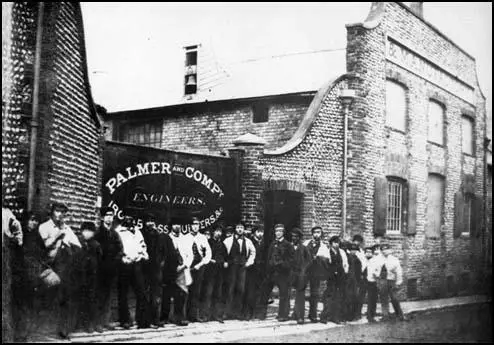
Workers
employed by Palmer & Co.Engineers stand
outside the company's premises in North Road. (c1865)
PART 5 :THE CARTE DE VISITE
CRAZE ( 1862-1870 )
The
Carte de Visite Format
In the early 1850s, a number of French photographers put forward
the idea of mounting a small photographic portrait on a card the
same size as the customary calling card. In 1854, a Parisian photographer
called Andre Adolphe Disderi (1819-1889) devised a multi-lens
camera with a collodion plate that could be moved to capture between
four and twelve small portraits on a single glass negative. This
meant that a photographer equipped with a camera with four lenses
could take a total of eight portraits, in a variety of poses,
all on one camera plate. From the resulting negative, the photographer
could produce a set of contact prints on albumenized paper, which
could then be cut up and pasted on to small cards. The card mounts
were the same size as conventional visiting cards (roughly 21/2
inches by 41/4 inches or 6.3 cm by
10.5 cm) and so this new format of photograph came to be known
as 'carte de visite' - the French term for visiting card.
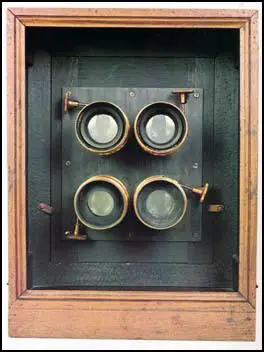 |
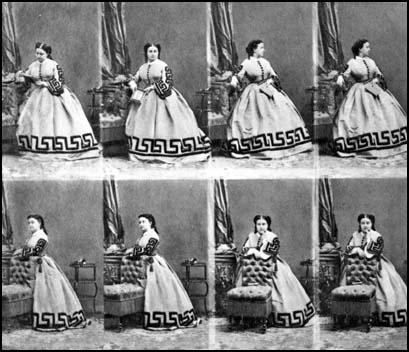 |
LEFT:An
early carte de visite camera. RIGHT: An
uncut sheet of 8 carte de visite portraits by Disderi. c1862
C
In 1857, Marion and Co, a French firm of photographic dealers
and publishers, introduced the carte de visite (cdv) format
to England. By 1859, the carte de visite portrait was fashionable
in Paris, but the new format was not immediately popular in this
country.
Celebrity Cartes
In May 1860, John Jabez Edwin Mayall, who was later to
open a photographic studio in Brighton, made a number of portraits
of the Royal Family. Mayall was given permission to publish the
portraits of the Royal Family as a set of cartes-de-visite. In
August 1860, the cartes were released in the form of a Royal Album,
comprising of 14 small portraits of Queen Victoria, Prince Albert
and their children. The Royal Album was an immediate success,
and the cartes sold in their hundreds of thousands.
LEFT:Queen
Victoria and Prince Albert by J J E Mayall (1861) One of the royal
portraits that was issued as a cdv.
RIGHT
:A page from The Royal Album, which featured cdv portraits
of the Royal Family by Mayall (1861)RIGTL
The
publication of a set of royal portraits started a fashion in Britain
for collecting carte de visite portraits of famous people. Another
series of royal portraits by Mayall was published in 1861. In
the December of that year, Queen Victoria's husband Prince Albert
succumbed to typhoid fever and his death created an enormous demand
for his portrait. The Photographic News later reported that within
one week of his death "no less than 70,000 of
his carte de visite were ordered from Marion & Co."
By the end of the decade, Marion & Co, had paid Mayall £35,000
for his portraits of the Royal Family.
Leading photographers made portraits of the famous personalities
of the day, which were then issued in carte de visite (cdv)
format and sold through retail outlets such as print sellers,
stationers, booksellers and fancy goods shop. The retail trade
dealt with cdv portraits of statesmen, politicians, actors, authors,
artists, entertainers and other famous people. By 1861, Thomas
Hill, who sold all manner of fancy goods at his shop at 66 East
Street, Brighton, was selling 'Albums for the Carte de Visite'
and had in stock a "great variety" of these celebrity
portraits.
Local Celebrity Cartes
In the early 1860s, Brighton studios were advertising cartes de
visite of local celebrities. William Hall, a former partner
in the photographic firm of Grey & Hall and now the sole proprietor
of the studio at 13 St James Street, was one of the first photographers
in Brighton to promote celebrity cartes. In a newspaper advertisement
dated 27th February 1862, Hall offered to the public cdv portraits
of "Eminent Ministers - taken from life." Hall
listed 20 church ministers who were featured in his cdv portraits,
including the Reverend T. Trocke of Chapel Royal and Reverend
J.L.Knowles of St Peter's Church.
In September 1862, the photographic firm Merrick & Co
of 33 Western Road, was offering for sale, at 1s 6d a copy, a
cdv portrait of 'The African Princess' who had married Mr.James
Davis at Brighton the previous month.
Portraits for the Masses
A portrait made by either the daguerreotype or collodion positive
process was unique and copies could only be made by re-photographing
the original. Disderi's carte de visite method meant that one
negative whole-plate could hold up to eight individual images.
This eight picture negative could then be used repeatedly to produce
multiple copies. A photographer could therefore produce eight
small portraits at one sitting and from a single negative produce
a large number of prints, thereby greatly reducing the cost of
each portrait. When William Hall was in partnership with
Stephen Grey at 13 St James Street in 1854 a small daguerreotype
portrait could be had for 6 shillings ( 30 p.) In 1862, at the
same studio, William Hall was offering to provide a dozen
cdv portraits at a price of 12 shillings ( 60 p.). High class
photographic establishments such as Mayall's new portrait studio
at 90-91 King's Road Brighton, priced a set of twelve cdv portraits
at £1.1s (£1.05p) when the studio opened in July 1864.
Hennah & Kent, another quality portrait studio in Brighton,
"got 21/- a dozen for cartes" according to A.H.Fry,
who worked for the studio in the early 1860s. At the other end
of the scale, The West-End Photographic Company, based
at 109 Western Road Brighton was charging 5s (25 p.) for twelve
cartes de visite in 1864. At the same studio a single cdv portrait
would cost 1 shilling ( 5 p.), three copies could be had for 2
shillings (10 p.), while six copies could be purchased for 3s
(15 p.)
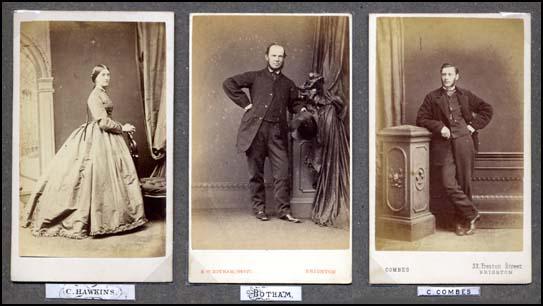
Carte de visite portraits
from Brighton photographic studios : HAWKINS; BOTHAM ;COMBES
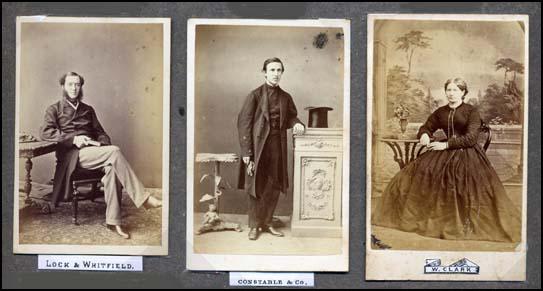
Carte de visite portraits
from Brighton photographic studios::LOCK
& WHITFIELD; CONSTABLE; CLARK
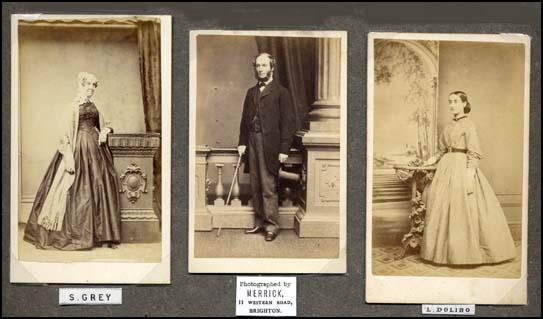
Carte de visite portraits
from Brighton photographic studios::GREY;
MERRICK; DOLIBO:
In the 1860s, every High Street photographer in Brighton recognised
the fact that the carte de visite (cdv) was the most popular
of the portrait formats. The cdv also generated the most income.
It is reported that J J E Mayall produced over half a million
cartes a year, which helped him secure an annual income of £12,000.
In December 1861, The Photographic News declared "At
the present time, we believe cartes de visite are the most renumerative
class of portraits produced by professional photographers."
The Photographic News pointed out that the cdv's profitability
stemmed from the fact they were "generally ordered in
quanitities." The cdv itself became an advertisement
and generated business. As The Photographic News explained:
"each one sent out is a recommendation and almost certainly
brings fresh customers. Thus a sitter orders a dozen copies; in
giving these to his friends, he places each one, to a certain
extent under the obligation of giving a portrait in return; and
thus it happens that every portrait taken becomes, as it were,
the nucleus of a fresh order."
"Cartomania"
With
the growing popularity of the cdv portrait, High Street photographers
experienced an increased demand for their services. A top London
studio could expect, on average, around 30 sitters a day, although
in the summer months the figure could be higher. In May 1861,
Camille Silvy's London studio recorded 806 customers for that
month alone. A provincial photographer reported that "fifteen
in a morning was considered a good day's work, although in the
summer it often rose to twenty-five."
Benjamin Botham arrived in Brighton to set up a photographic
portrait studio around 1861. When he decided to sell his studio
seven years later in order to begin a new career as the proprietor
of the Oxford Theatre of Varieties, he passed on nearly 10,000
negatives to his successor.
The demand for carte de visite portraits led to a further
growth in the number of portrait studios in Brighton.In
1858, there were around 16 photographic studios in Brighton. By
1862, when the carte de visite craze was taking off, the number
of portrait studios in Brighton had risen to 21. Lane's Photographic
Portrait Rooms at 213 Western Road became the photographic studio
of The Carte de Visite Co., with William Lane acting
as manager. At the height of the cdv craze in 1867, there was
a total of 37 studios in Brighton, most of which were supplying
cdv portraits.
High Street Photographers from London
The
1860s saw the arrival of large London firms intent on establishing
branch studios in Brighton.
Dickinson Brothers was a leading firm of printers and publishers
based at 114 New Bond Street. The company had achieved national
recognition for a set of 55 large, coloured lithographs, entitled
'Comprehensive Pictures of the Great Exhibition of 1851',
which illustrated the various display areas at the Crystal Palace.
By 1855, Dickinson Brothers had become interested in photography
and had established two photographic portrait studios in London,
one at their premises in New Bond Street and the other at 174
Regent Street. Dickinson Brothers established a branch studio
at the prime site of 70-71 Kings Road, Brighton around 1862. Lowes
and Gilbert Dickinson carried on their photographic portrait business
in Brighton until 1868, when the demand for carte de visite portraits
had begun to decline.
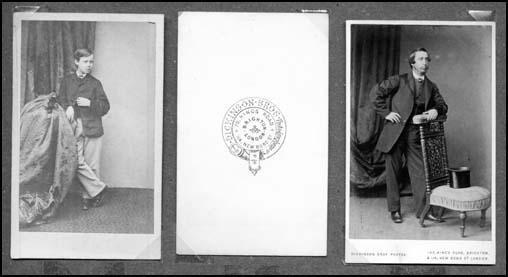
Around
1862 the London firm of Dickinson Brothers established a photographic
studio at 70 Kings Road, Brighton. By 1867, Dickinson Brothers
had moved their photographic portrait studio to 107 Kings Road,
Brighton, next door to Hennah & Kent at No 108, and Lock &
Whitfield at 109 Kings Road.
1864 saw the arrival of two companies which had already established
a reputation for high class portrait photography in London's fashionable
Regent Street - J J E Mayall and Lock & Whitfield.
Lancashire born John Jabez Edwin Mayall (1813-1901) the
son of a manufacturing Chemist and Dye Works proprietor, had begun
his working life near Huddersfield, West Yorkshire, but around
1842, he travelled to America to study the art and science of
photography under the tutelage of two scientists attached to the
University of Pennsylvania. In 1844, Mayall entered into partnership
with Samuel Van Loan and together they operated a daguerreotype
portrait studio in Philadelphia. A few years later, Mayall returned
to England and by April 1847 he had established a Daguerreotype
Institution at 433, West Strand, London. By 1852, Mayall had opened
a second studio at 224 Regent Street in the West End of London.
Mayall had secured the patronage of Queen Victoria and the Royal
Family and between 1860 and 1862, he published sets of royal portraits
in the carte de visite format, which triggered a craze for collecting
cdv portraits. Mayall achieved fame and fortune. In the year 1861,
he reportedly made £12,000 from his carte de visite portraits.
Leaving
his eldest son Edwin to run his London studios, John J.E.Mayall
moved down to Brighton with his wife and two younger sons
and on 18th July 1864, he opened his new photographic portrait
studio at 90-91 Kings Road, close to the recently built Grand
Hotel. In an announcement placed in the pages of the Brighton
Examiner, Mayall declared that he had "spared neither pains
nor expertise in preparing, for the accommodation of the nobility
and gentry resident at or visiting Brighton, one of the most efficient
studios ever built." Although he addressed his comments particularly
to the "nobililty and gentry", Mayall admitted that
he was "not unmindful of the fact . . . that moderate charges
are as necessary as general excellence to ensure extensive public
patronage." Mayall charged £1.1s (£1.05p) for
a set of 12 carte de visite portraits and £5.5s (£5.25p)
for his "highly finished" coloured portrait photographs.
More modest establishments in Brighton were offering a dozen carte
de visite portraits for 5 shillings (25 p.) in 1864.
Mayall made the guarantee that his new Brighton studio would be
"as successful in operation as it is complete in design".
Mayall's name remained on the Kings Road Studio until 1908, seven
years after his death. Mayall, who lived in the Brighton area
until he died in Southwick on 6th March 1901, involved himself
fully in the life of the town and became active in local politics
and in 1877 he was made Mayor of Brighton.
Lock
& Whitfield, Photographers and Miniature Painters of 178
Regent Street, London established a branch studio at 109 Kings
Road, Brighton in 1864, a few months after Mayall opened his studio
on the same fashionable highway.
Samuel Robert Lock (1822-1881) was an artist who in the
early 1850s was converting talbotype portraits into painted miniatures.
In September 1856, he joined forces with George C.Whitfield
(born c.1833) who had recently built a photographic portrait
studio in London's Regent Street.
In an advertisement placed in a Brighton newspaper, dated 20th
September 1864, Lock & Whitfield offered to take "carte
de visite and every description of photograph, colored or uncolored
(sic), on paper, ivory or porcelain."
Lock & Whitfield was in direct competition with the
other firms from London, Mayall and the Dickinson Brothers, which
also had their studios on Brighton's Kings Road. By 1867, Lock
& Whitfield had fixed the price of twenty carte de visite
portraits at £1.1s.6d (roughly £1.06p.)
Lock & Whitfield probably employed a manager to run their
Brighton studio in the 1860s, but by the time of the 1871 Census,
George C Whitfield was living at Upper Rock Gardens, Brighton
with his wife and five children. Samuel Lock took up residence
in Brighton in 1877, but died 4 years later on 9th May 1881. Lock
& Whitfield's Brighton studio at 109 Kings Road was taken
over by another chain of photographers, Debenham & Co
in 1886.
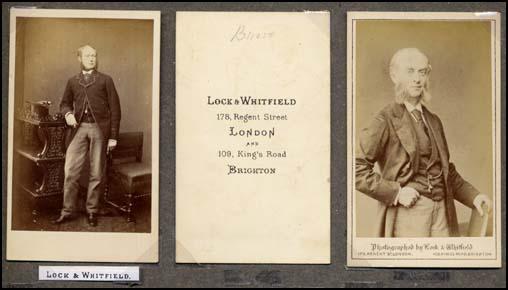
Carte
de visite portraits taken in Brighton by the London firm of Lock
& Whitfield. After they established a studio in Brighton at
109 Kings Road in 1864, the partners continued to operate a portrait
studio in London at 178 Regent Street.The studio in Regent Street
carried the name of Lock & Whitfield until around 1895.
The
Cabinet Format
In 1866, Frederick Richard Window, a London photographer
who had introduced the Diamond Cameo Carte de Visite two years
earlier, put forward the idea of a larger format for portrait
photography. The proposed format was a photographic print mounted
on a sturdy card measuring 41/4 inches by
61/2 inches. (roughly 11cm x 17cm). The
new format was called the Cabinet Portrait, presumably
because a large photograph on a stout card could be displayed
on a wooden cabinet or similar piece of furniture. The Scottish
photographer George Washington Wilson (1823-1893) had produced
'cabinet' sized landscape views as early as 1862, but F.R.Window
had adopted the large format specifically for portraiture.
Window believed the larger dimensions of the 'cabinet print' (4
inches by 51/2 inches
or approximately 10.2 cm x 10.2 cm x 14.1 cm) would enable the
professional photographer to demonstraste his technical and artistic
skill and produce portraits of a higher quality than the small
cdv would allow.
The cabinet photograph increased in popularity as the demand
for carte de visite portraits fell. Much larger than the cdv,
the size of the cabinet format made it more suitable for group
and family portraits.
|
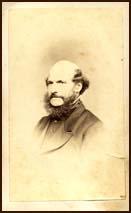
Carte de visite portrait
of a bald headed gentleman by Mayall's Brighton studio.On
the right is the same portrait in the larger cabinet format.
The cabinet portrait was mounted on a sturdy card which
often ,as in this example, carried the name and address
of the studio in gold lettering against a black background.
[ SEE ILLUSTRATION AT RIGHT ]
|

Cabinet portrait by
J E Mayall of 91 Kings Road, Brighton
|
Advertisements for the 'New Cabinet Portraits' appeared in Sussex
newspapers at the end of 1867. A single cabinet photograph would
cost 3 shillings (15 p.) and a dozen copies could be had for 15
shillings. (75 p.). By 1877, the studio of C. Hawkins of
Preston Street, Brighton would make the first copy of a cabinet
portrait for 2s 6d (121/2 p) while a dozen copies would cost 12
shillings. (60 p.)
PART
6 : 'Dry Plate' Photography
The collodion wet plate process produced excellent results,but
had major drawbacks. The photographer had to coat the glass plate
evenly with the sticky collodion solution immediately before use
and each stage of the process - sensitizing, exposing and developing
- had to be done while the plate was still wet. "Wet plate"
photography was difficult enough in the studio and darkroom but
outdoor photography was particularly troublesome. A photographer
who wanted to operate away from his studio would have to carry
with him a large amount of heavy equipment, including glass plates,
a tripod, bottles of chemicals and some sort of portable darkroom,
as well as the bulky camera itself.
Attempts were made in the 1860s to produce 'dry plates'
for photography. Glass plates were either coated with alternate
layers of albumen and collodion or an emulsion of silver bromide
in collodion. The "wet plate" process had to be carried
out in the 10 to 20 minutes it took for the collodion to dry.In
contrast, these pre-coated 'dry plates' could be stored, used
in the camera when required and processed when convenient. However,
these early "dry plates", were not very light sensitive
and required exposure times of up to fifteen minutes.
The search continued for a substance that could bind light sensitive
materials to the glass plates, but allowed fast exposure times.
In 1871, Richard Leach Maddox (1816-1902) a doctor with
a strong interest in photography, proposed the employment of gelatin,
the transparent substance which is used to make jellies. Dr Maddox's
idea was taken up by other experimenters, including Charles
Bennett, who discovered that prolonged heating of the gelatin-silver
bromide emulsion would increase its sensitivity to light. Applying
this method, Bennett was able to produce dry plates with
exposure times of a fraction of a second.
|
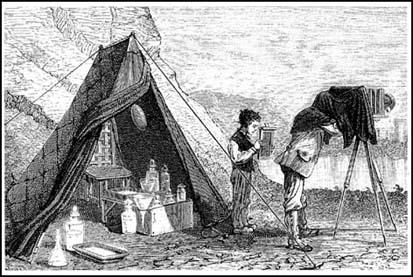
[ABOVE]
Photography outside of the studio before the introduction
of photographic "dry plates". This engraving,
which dates from the 1870s, shows the photographer with
his camera on a tripod, his young assistant holding the
"wet collodion plate" in a slide frame, and behind
him a darkroom tent containing a chest of chemicals and
other photographic materials. All this equipment had to
be transported to the location by a photographer using the
"wet collodion " process.
|
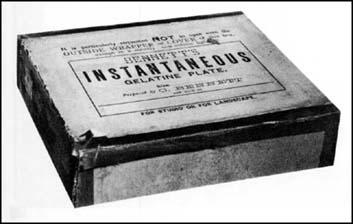
[ABOVE] A
pack of Bennett's Instantaneous Gelatine Photographic Plates.
These "dry plates" were manufactured by Charles
Bennett,who perfected the "dry plate" process
in the late 1870s.
|
By
the end of the decade 'gelatine dry plates' were being manufactured
on a large scale. Samuel Fry, a professional photographer
who had been active in Brighton between 1858 and 1860, established
a factory to produce 'ready made' dry plates in the late 1870s.
By 1879, there were more than 14 firms manufacturing "dry
plates". Manufactured gelatin dry plates were evenly coated
by machine and were consistent in quality and could be stored
for weeks or months before exposure and development.
Instantaneous Photography
In the 1860s, Edward Fox junior, Brighton's leading landscape
photographer, was offering to take "Instantaneous Portraits
of Animals, Groups etc." in Brighton and the surrounding
area. We do not have details of the special apparatus or techniques
that Fox employed to take instantaneous photographs in the 1860s,
but it was not until the introduction of the highly sensitive
gelatin dry plates in the late 1870s, that other Brighton photographers
started to use the term "instantaneous".
The greater sensitivity of manufactured dry plates reduced the
length of exposure times to a fraction fof a second,. Although
the use of gelatin-bromide dry plates did not have a great impact
on the work of the photographer producing single portraits in
the studio, it did enable professional photographers to extend
their photographic repertoire.
Photographing children and family groups
To hold a pose for a number of seconds proved difficult for restless
and fidgety children and uncomfortable for elderly or disabled
sitters. In 1879, Henry Spink, who had a studio in Western
Road, Brighton and another at Goldstone Villas in Cliftonville,
was advertising "an instantaneous process for invalids
and children. Satisfaction guaranteed. First rate photographs
taken in any weather at any hour of the day."
In the early 1850s, when exposure times were lengthy, making portraits
of children or a group of several figures were regarded as difficult
operations. In 1853, Robert Farmer of 59 North Street,
Brighton advertised that the time of a sitting was ten seconds.
To make a good portrait of a child or a large family group necessitated
skill and patience and Robert Farmer introduced a scale of charges
that reflected the additional effort required. Farmer charged
1s 6d (71/2p) for a single portrait of a man or woman, but a portrait
of a child under 10 years would cost 2s 6d (121/2p), a group of
three children, 7s 6d (371/2p) and the price of a portrait of
a family group made up of five people was fixed at 10s 6d (521/2p)
In 1864, when carte de visite portraits were the norm, a set of
12 cdv portraits of a single figure would cost £1. 1s (£1.05p)
at Mayall's new photographic portrait studio in Brighton's Kings
Road. J J E Mayall charged extra for more than one sitter.
A cdv portrait of a couple would be priced at £1.11s 6d
(£1.571/2p) for a set of 12, while a dozen copies of a portrait
of three people would cost £2.2s (£2.10p).
In 1878, the firm of C Hawkins of Preston Street, Brighton
were offering to photograph large groups on "moderate terms".
An advertisement for Hawkins' studio in January 1881, when the
larger cabinet format and instantaneous photography were making
family portraits more popular, does not mention additional charges
for groups of sitters.A cabinet size portrait of a family would
cost 2s 6d (12 1/2 p ) at Hawkins' studio in 1881.
Capturing the Moving Figure
When Louis Jacques-Mande Daguerre made his daguerreotype
of the Boulevard du Temple in 1838, the exposure time was so long
(probably between 10 and 20 minutes) he was unable to capture
the hurrying figures and the moving traffic in this busy Paris
Street. Only a man who had to remain still while his shoes were
polished by a boot-black, was completely captured on Daguerre's
silvered copper plate. Although, as a contemporary noted at the
time, the boulevard in question was "constantly filled
with a moving throng of pedestrians and carriages", the
street in Daguerre's early photograph appeared to be completely
deserted "except for an individual who was having his
boots brushed." In fact, the shoeshine man himself must
also be included as one of the first human figures to be depicted
in photography. But as a German magazine of 1839 observed, the
man "having his boots polished . . . must have held himself
extrenely still for he can be very clearly seen, in contrast the
shoeshine man, whose ceaseless movement causes him to appear completely
blurred and imprecise."
By the 1860s, photographic exposure times had been reduced to
a few seconds, but this still meant that a person who moved suddenly
while the photograph was being taken would become blurred and
indistinct and a figure who passed rapidly in front of the camera
would become almost invisible, leaving only a feint ghostly shape
on the negative.
Specially prepared gelatin dry plates were so sensitive that out
of doors and in bright sunlight exposure times could be as brief
as one twenty fifth of a second.
Photography
on Location
Dry plate photography
encouraged the professional photographer to leave his studio and
journey to the homes of his customers. No longer weighed down
by heavy wooden chests filled with bottled chemicals nor encumbered
by a darkroom tent, professional photographers were ready to travel
longer distances in order to secure commissions. Early in 1881,
Messrs Lombardi & Co a firm of photographers with a
town studio at 113 Kings Road, Brighton placed advertisements
in the local press "to inform the Gentry and Clergy of
Sussex that they are now prepared to Visit the different Estates
in this and other Counties to Photograph Buildings, Horses, Groups
etc. etc . . Schools attended either in town or country."
As early as 1867, Messrs W. & A.H. Fry artists &
photographers of 68 East Street, Brighton had specialised in taking
photographs of groups out-of-doors. An advertisement in the Brighton
Guardian of 14th August 1867 announced they had "Special
Apparatus for taking Out Door Pictures of School Groups, Cricket
Elevens, Croquet Parties, Archery Meetings, Rifle Corps and Country
Seats." Having already established a reputation for outdoor
group photography, Walter Fry and his younger brother,
Allen Hastings Fry, were keen to take advantage of the
mobility afforded by dry plate photography. In an article
published in 'The Professional Photographer' in June 1916,
Allen Hastings Fry looked back over his long photographic
career. The magazine observed that Mr Fry appeared to be "a
portait photographer glad to get away from the confinement of
his studio." In the interview, A.H.Fry revealed that
he had "photographed two hundred Public School Cadet and
Officers' Training Corps", adding the observation that
he had "travelled over 9,000 miles during the year I was
taking the photographs."
Website
last updated: 23 December, 2002
This
website is dedicated to the memory of Arthur T. Gill (1915-1987), Sussex
Photohistorian
|



 Portrait
of Richard Beard (1801-1885)
Portrait
of Richard Beard (1801-1885) 

 ,.
,.














